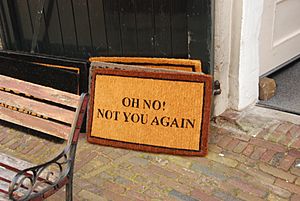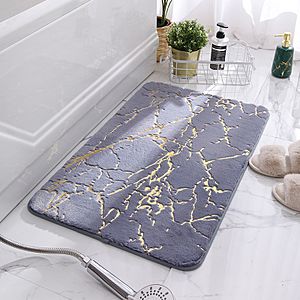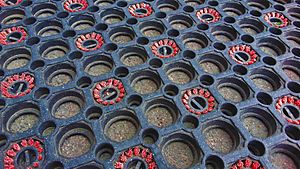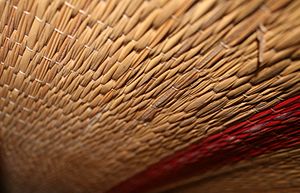Mat facts for kids
A mat is a flat covering, usually made of a strong material, that you place on a floor or other flat surface. Mats are super useful and have many different jobs! They can help keep things clean, like a doormat that wipes dirt off your shoes. They can also protect things, like a soft mat used for gymnastics to keep you safe, or a place mat that protects your table from hot plates. Some mats even provide a smooth surface, like a mousepad for your computer mouse.
Contents
Types of Mats
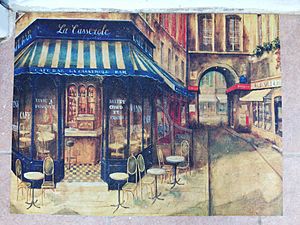
Mats for Your Home
- In some homes, especially in countries like Japan or Korea, people often sit on the floor. So, mats like the traditional Japanese tatami mats might cover a whole room. People usually take off their shoes before walking on these mats to keep them clean.
- A doormat is a flat mat, usually rectangular, that you put right outside or inside your front door. Its main job is to let people wipe their shoes clean before they come inside. Doormats are made from tough stuff like coir (from coconuts), rubber, or strong cloth. Sometimes, a doormat is called a "welcome mat" because it's at the entrance, and it might even have a friendly message on it!
- A cabinet mat is a special mat made of rubber. It protects the inside of kitchen cabinets, especially under the sink, from water leaks, spills, and even mold.
- A bath mat goes on the floor in your bathroom. It gives you a warm, non-slip surface when you step out of the shower or bath. It also soaks up small amounts of water, just like a towel.
- A place mat is a flat piece of fabric or other material used on a table during meals. It sits under your plate and dishes. Place mats protect the table from hot plates and spills.
Car Mats
A car mat is designed to protect the carpeted floors inside a vehicle. Its main purpose is to catch mud, sand, and snow, keeping the car's original carpet clean. Some car mats have special clips to make sure they stay in place and don't slide around.
Car mats can be made of carpet or rubber. Carpet mats are soft and usually have a rubber backing to prevent slipping. Rubber car mats are tougher and last a long time. While some are plain, many have company logos or fun designs. You can find "universal" mats that fit many cars, or "custom fit" mats made for one specific car model.
Anti-Fatigue Mats
Anti-fatigue mats are made for people who stand for a long time, like workers in factories or surgeons in hospitals. These mats help reduce tiredness and discomfort. They have a soft, cushioned layer that makes you slightly adjust your balance all the time. These tiny movements help your blood flow better in your legs, which means less pain and fatigue.
These mats also protect your feet from hard, cold floors, vibrations, and noise. Studies have shown that people who stand on anti-fatigue mats can feel up to 50% less tired! They are often recommended for safety in workplaces. Anti-fatigue mats are made from materials like vinyl, rubber, or foam. They come in different types for various jobs, like fire-resistant mats for welding or special mats for food factories.
Cleanroom Mats
The main goal of a cleanroom mat is to keep very clean areas, like laboratories or special factories, free from dirt, bacteria, and anything else brought in from outside. Cleanroom mats are usually sticky and have many layers of film. When someone walks over them, the sticky surface traps dirt and dust from their shoes. You can peel off a dirty layer to reveal a fresh, clean one underneath.
Another type of cleanroom mat is a "sanitizing foot bath." This mat is like a shallow tray filled with a cleaning liquid. As you step in, rubber scrapers clean your shoes, and the liquid disinfects them. There are also mats made from special plastic materials that can be cleaned with a mop and detergent.
Mats can be:
- One-piece mats: These are single mats, often rectangular, square, round, or oval. They come in many sizes and colors and are used permanently.
- Linear length mats: These are sold in long rolls, perfect for covering long areas like assembly lines.
- Modular mats: Also called interlocking tiles, these mats are like jigsaw puzzles. They come in several pieces that fit together easily. They are great for oddly shaped areas or for temporary use, like at sports events or trade shows, because they are easy to set up, take down, and store.
Rubber Grass Mats
Rubber grass mats are often used in playgrounds, schools, and backyards, especially under play equipment where someone might fall. They are a simple way to make play areas safer. These mats are usually laid directly on grass or soil. They are made from rubber and have many holes, which allows the grass to grow through them. This makes the area safe while still looking green and natural.
These mats are also useful for temporary events like festivals or weddings. They can create paths or standing areas, protecting the grass from getting worn out. They are easy to install by pegging them into the ground and connecting them with ties, and they can be removed quickly without harming the grass.
Other Types of Mats
- An anti-vibration mat stops shaking. It's used to prevent heavy machines from vibrating too much and damaging the floor. It can also protect sensitive equipment, like machines that make computer chips, from outside vibrations.
- A slipmat is a round, slippery mat used by disc jockeys (DJs). It lets them easily turn or stop vinyl records on their record players, or do "scratching" sounds.
- A bar mat is a rectangular mat, usually made of rubber, used on a bar counter. It protects the counter and soaks up any spilled drinks.
- An entrance mat is like a doormat but often larger, used in the entrances of buildings. Its job is to trap and hold dust and dirt, and also to absorb moisture to prevent people from slipping. This helps keep the inside of the building cleaner and safer.
History of Mats
Matting or floor covering refers to many types of rough, woven or braided materials used to cover floors or furniture. It can also be used as screens or for wrapping goods. In the United Kingdom, a lot of coarse carpet called "coir" matting is made from coconut fibers. The same material, along with strips of cane, manila hemp, and various grasses, is used to make doormats.
These coconut fiber mats are woven on large looms, then cut into different sizes and bound around the edges with rope from the same material. Mats can be one color or have different colors and designs. Sometimes, names of places or groups are even woven into the mats.
Because it's soft and strong, jute matting has also become popular for floor coverings, doormats, and runners. Jute mats are woven in southern India in many colors and patterns. They are very popular in countries like the USA and Europe because they are soft. Jute can also be easily colored or printed with eco-friendly dyes. Hand-knotted jute carpets are also made in Kerala, India.
Another type of mat is made only from coir rope, arranged in wavy and straight lines, then stitched together. This is also used for the outer covering of ship fenders (things that protect ships from bumping into docks). Mats made from rubber and wire are also used for doors and floors.
Mats of many kinds are widely used throughout India for floor coverings, bed bottoms, and fans. India also exports many of these mats. The materials used are varied, but common ones include straw, bulrushes, leaves from date palms, coconut palms, and different types of grasses like Cyperus textilis and Cyperus pangorei.
The mats made from Cyperus pangorei (called "Korai" grass in Tamil) are known as "Korai paai" in the Tamil region of Tamil Nadu. They are usually about 6 feet by 3 feet and are often dyed in bright red, green, or purple patterns. These mats vary in how flexible, fine, and expensive they are. The "Pattamadai paai," named after the Pattamadai region, is considered one of the finest. Many Indian grass-mats are beautifully designed with rich, harmonious colors. Mats from Vandavasi are also well-known. Nowadays, you can also find plastic mats, which are cheaper and easier to clean.
This type of mat-making is common in India, Japan, and other Eastern countries. In Russia, large amounts of coarse matting used for packing furniture and other goods are made from the inner bark of the lime tree. This industry is mainly found in the large forest areas of Viatka, Nizhniy-Novgorod, Kostroma, Kazan, Perm, and Simbirsk.
See also
 In Spanish: Felpudo para niños
In Spanish: Felpudo para niños


